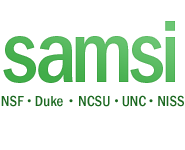Experimental Design and Inverse Problems in Plant Biological Modeling Project for IMSM 2011
Dr. Laura Potter
Syngenta Biotechnology
Research Triangle Park, NC
Dr. H.T. Banks
Department of Mathematics
North Carolina State University
Raleigh, NC
Project Description
Plants are highly dependent on and responsive to their surrounding environments. Factors such as light, temperature, soil quality, planting density and pest pressure all have a strong impact on plant growth and reproduction. In many cases, molecular mechanisms have been elucidated that sense these environmental cues and trigger downstream responses. Understanding these biological mechanisms and the overall effects of the environment is an active area of research in plant biology, with important applications to agricultural research. Mathematical modeling of the underlying biology and the downstream plant response is a promising approach for gaining new insight in this area.
As with many other types of biological models, the contributions of variability and stochasticity from environmental and genetic factors must be carefully considered when developing, calibrating and validating models of plant biology. This issue is critically important in the context of experimental design and parameter estimation, where environmental conditions, plant-to-plant variability, and sampling strategies could have significant impacts on the quality of the experimental data and the resulting model parameterization.
This project will focus on gaining a better understanding of how environmental and genetic variability can affect model development, and how to better account for these factors into experimental design and inverse problem formulations. We will work with an example model from the literature to explore these issues by testing various scenarios of uncertainty and stochasticity in the data and the model. The desired outcome is a series of recommendations on which factors appear to be most critical to model development in this area, and approaches for improved experimental design and parameter estimation methods that take these factors into account.
Photosynthesis Tutorials
Enzyme Kinetics Tutorial
References
X.-G. Zhu, E. de Sturler and S.P. Long:
Optimizing the Distribution of Resources between Enzymes of Carbon Metabolism Can Dramatically Increase Photosynthetic Rate: A Numerical Simulation Using an Evolutionary Algorithm
Plant Physiology, vol. 145, pp 513-526, 2007
H.T. Banks and S. Hu:
Nonlinear stochastic markov processes and modeling uncertainty in populations,
Technical Report CRSC-TR11-02, NCSU, January 2011
H.T. Banks, K. Holm and F. Kappel:
Comparison of optimal design methods in inverse problems,
Technical Report CRSC-TR10-11, NCSU, July 2010
H.T. Banks, M. Davidian, J.R. Samuels Jr. and K. L. Sutton:
An inverse problem statistical methodology summary,
Technical Report CRSC-TR08-01, NCSU, January 2008
H.T. Banks, J.L. Davis, S.L. Ernstberger, S. Hu, E. Artimovich, A.K. Dhar and C.L. Browdy:
A comparison of probabilistic and stochastic formulations in modeling growth uncertainty and variability,
Technical Report CRSC-TR08-03, NCSU, February 2008
Also in: Journal of Biological Dynamics, vol. 3, pp 130-148, 2009
H.T. Banks, J.L. Davis, S.L. Ernstberger, S. Hu, E. Artimovich and A.K. Dhar:
Experimental design and estimation of growth rate distributions in size-structured shrimp populations,
Technical Report CRSC-TR08-20, NCSU, November 2008
Also in: Inverse Problems, vol. 25, 095003(28pp), September 2009
H.T. Banks, J.L. Davis and S. Hu:
A computational comparison of alternatives to including uncertainty in structured population models,
Technical Report CRSC-TR09-14, June 2009
Also in: Three Decades of Progress in Systems and Control, X. Hu, U. Jonsson, B. Wahlberg, B. Ghosh (Eds.), Springer, 2010.
